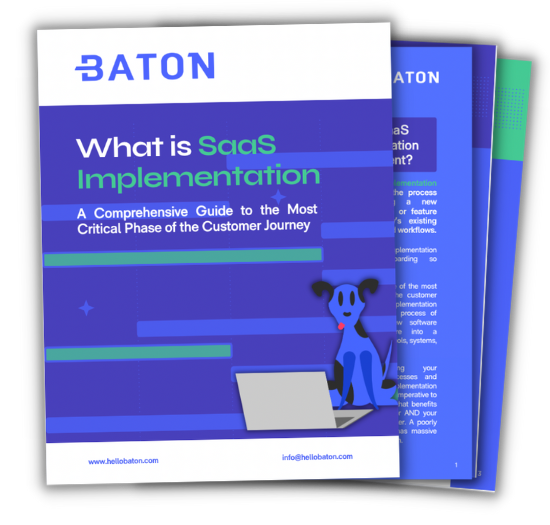In the competitive world of software development, a company’s profitability hinges not only on the quality of its products but also on the efficiency and effectiveness of its services and client experiences. When looking for ways to maximize profitability, many software leaders look to streamline their client onboarding and implementation processes to positively impact their bottom line and improve customer satisfaction, retention, and overall financial success.
The Role of Client Onboarding When Maximizing Profitability
Client onboarding is the initial phase of a customer’s journey with a software company, and it sets the tone for the entire relationship. A seamless onboarding process is not just about getting clients up and running quickly; it’s about building trust and ensuring customers see value in the software from the start.
1. First Impressions Matter When Building Client Relationships
Clients form their first impressions during the onboarding process. A smooth and well-organized onboarding experience creates a positive perception, making clients more likely to engage with the software and continue their partnership.
2. Reducing Time to Launch and Time to Value
Efficient onboarding accelerates the time it takes for clients to get up and running on your platform and begin realizing the value of their investment in your software and services. When customers see results sooner, they are more likely to remain satisfied and renew their subscriptions or contracts, positively impacting the company’s recurring revenue.
3. Avoiding Failure to Launch Churn
Inadequate onboarding often leads to frustration and dissatisfaction among clients. A negative onboarding experience may cause a newly signed client to question their investment and your team and solution’s reliability, resulting in customer churn, where clients abandon the software in search of alternatives. Minimizing churn is vital for maintaining a stable customer base and sustaining profitability.
Implementation's Impact on Profitability
While onboarding introduces clients to the software, the implementation process is where the rubber meets the road. A successful implementation ensures that the software aligns with the client’s specific needs and business processes, maximizing its utility.
1. Tailoring Solutions to Individual Client Needs
No two implementation projects are alike, making customization during this phase of the customer journey critical. Software companies must understand the unique requirements of each client and tailor the solution and project plan accordingly. This not only enhances client satisfaction but also contributes to long-term relationships and positive word-of-mouth referrals.
2. Avoiding Costly Revisions and Changes to Project Scope and Timelines
A well-thought-out implementation process minimizes the likelihood of costly revisions or fixes later on. Addressing client needs accurately the first time reduces the resources spent on post-implementation support, ultimately contributing to higher profitability. While some shifts in timelines and tasks are inevitable, a well defined implementation process will help you proactively adapt and communicate and changes to the initial plan, while also tracking metrics like project baselines to help you plan accordingly.
3. Ensuring and Monitoring User Adoption and Engagement
A successfully implemented software solution is one that users adopt seamlessly. The implementation process should include comprehensive training and support to ensure clients’ teams can fully leverage the software’s capabilities. Higher user adoption rates lead to increased client satisfaction and, consequently, improved customer retention.
Maximizing Profitability Through Streamlined Processes
To ensure optimal profitability, software companies must focus on streamlining their client onboarding and implementation processes. This involves adopting best practices and leveraging technology to enhance efficiency.
1. Investing in Project Automation Tools
Automation can significantly reduce manual tasks and streamline the onboarding and implementation processes. From data migration to configuration, automation ensures accuracy and expedites the time it takes to get clients up and running.
2. Clear and Consistent Communication Channels
Establishing clear communication channels between the software company and the client is paramount. Regular updates, transparent timelines, and proactive issue resolution create a sense of trust and confidence, fostering a positive client experience.
3. Continuous Improvement Opportunities
Client onboarding and implementation are not static processes. Software companies must continuously assess and refine their procedures based on client feedback, industry trends, and internal evaluations. This commitment to improvement ensures ongoing efficiency and effectiveness.
4. Project Audit Trails for Data-Driven Decision-Making
Leveraging data analytics provides valuable insights into the effectiveness of onboarding and implementation processes. By analyzing key performance indicators, software companies can identify areas for improvement, allocate resources strategically, and make data-driven decisions that positively impact profitability.
The Influence of Client Onboarding and Implementation on Profitability
In the ever-evolving landscape of software development, a company’s profitability is intrinsically tied to its ability to onboard and implement solutions efficiently. A positive onboarding experience sets the stage for a successful client relationship, while a well-executed implementation ensures that clients derive maximum value from the software.
By investing in streamlined processes, embracing automation, and fostering continuous improvement, software companies can not only enhance client satisfaction but also bolster their bottom line. The impact of client onboarding and implementation on profitability cannot be overstated; it is the foundation upon which long-lasting, mutually beneficial relationships with clients are built. As the software industry continues to grow, those companies that prioritize these critical processes will undoubtedly stand out in a competitive market and secure a prosperous future.

What is SaaS Implementation – Comprehensive eBook
Deep dive into the key components of a SaaS implementation plan, how purpose-built technology can be utilized to streamline the implementation and onboarding process, and real-life examples of how the industry’s leading companies are creating positive and fruitful implementation experiences.



